With their creativity, Breeders brought us the stunning Mustard Gas Betta Fish.
This recent addition to the aquatic world has quickly become a favorite of aquarium lovers.
Thanks to its captivating colors, it now enjoys top status among unique Betta species.
However, the allure of the Mustard Gas Betta has led to a rise in duplications.
You might wonder, “How do I distinguish a genuine Mustard Gas Betta from an imitation?”
Don’t worry! This article will clearly explain the unique characteristics of the original Mustard Gas Betta.
It will also compare its color variations with similar species.
Table of Contents
What Is a Mustard Gas Betta?

The original Mustard Gas Betta, a bicolored fish species, sports dark blue or green bodies paired with solid pale yellow fins.
Today’s variants are vividly colored, starkly contrasting with their original counterparts.
You’ll notice that some versions even possess contrasting fin edges in blue, green, or black – a dramatic foil to the rest of the fin’s bright yellow hue.
Often, the body’s blue color spills into the fins partially, creating an appearance akin to a butterfly pattern.
You might even see a sprinkle of orange accompanying the traditional duo of blue and yellow.
New aquarists could mistake the Mustard Gas Betta for the Chocolate Betta due to their semblance.
Chocolate Bettas, however, flaunt a rich brown body instead of blue or green.
Adding to the confusion is the Pineapple Betta, resembling both Mustard Gas and Chocolate Bettas.
These yellow-dominated fish boast black-outlined body scales.
The International Betta Congress recognizes Betta Fish with the same colors on their body and tail, such as Mustard Gas, as bi-colored.
Notably, the Mustard Gas Betta lacks a fixed tail type. Breeders often opt for long-finned tail types, given their popularity among enthusiasts.
Some common tail types include Halfmoon, Delta/Super Delta tail, Rosetail, and Crowsail.
Historically, Mustard Gas Bettas mainly had halfmoon tails. Even today, the halfmoon tail remains popular for highlighting the beautiful contrast between the body and tail colors.
Color Variations of Mustard Gas Bettas
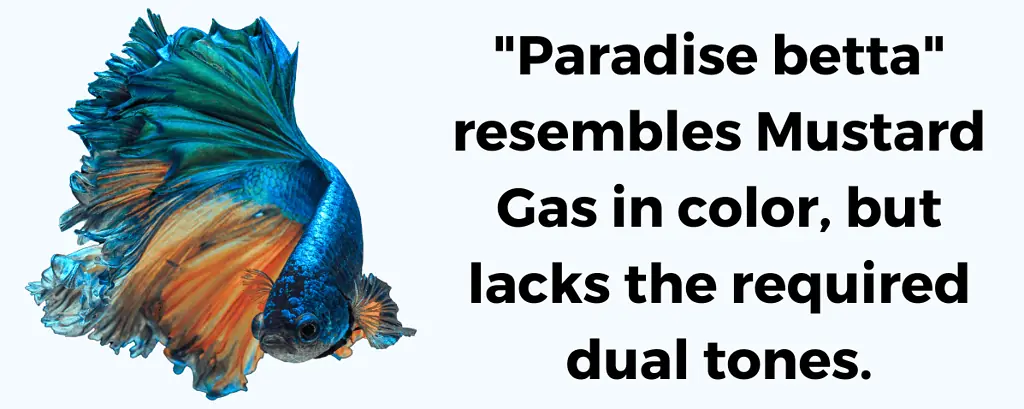
Betta Fish enthusiasts often breed Mustard Gas Bettas with different color patterns.
This allows various unique color morphs distinct from the original Mustard Gas pattern.
Some variants are so unique they’re sold under different names.
You might see a “Paradise Betta” at a pet store.
This is usually given to a Betta that resembles the Mustard Gas Betta in color but does not meet the two-color criteria that define the breed.
Blue
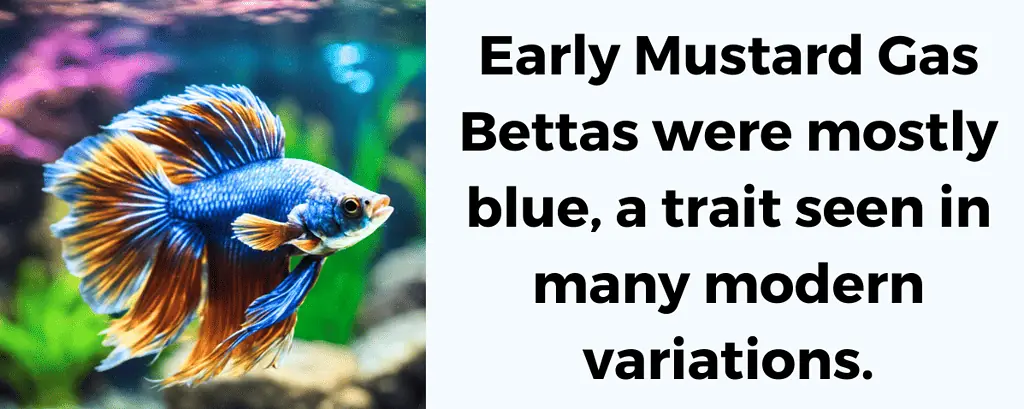
The original Mustard Gas Bettas were predominantly blue. This character remains prominent in many modern variants.
However, while the initial body color skewed toward dark blue, the contemporary versions exhibit both light and dark blue body colors.
This blue hue elegantly contrasts with the mustard-yellow tail and fins.
Green
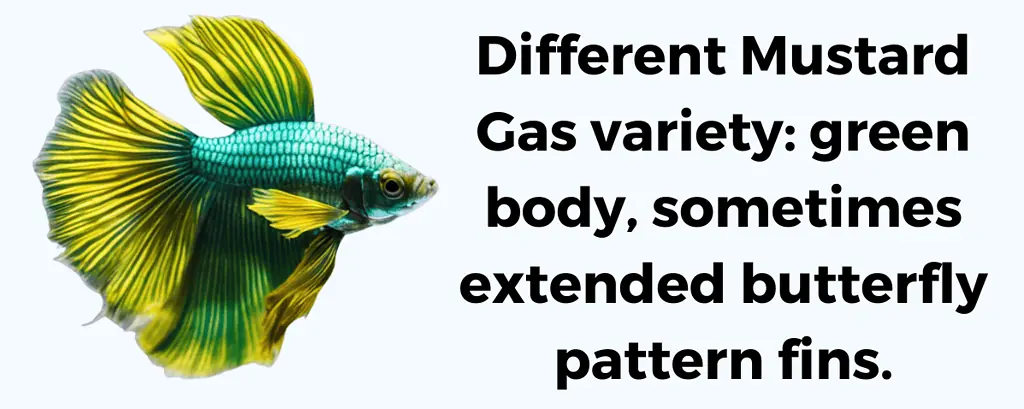
A novel Mustard Gas color variation, here, green replaces the traditional blue body. Sometimes, the green color seeps into the fins, mirroring the butterfly pattern.
Genuine green Bettas are non-existent; the green hue is a mastery of iridescence.
Orange and Blue

These bright variants of Mustard Gas Bettas stand out with their vibrant orange fins – a far cry from the muted mustard hue of the originals.
This duo imparts a striking visual appeal as blue and orange are complementary colors.
Black
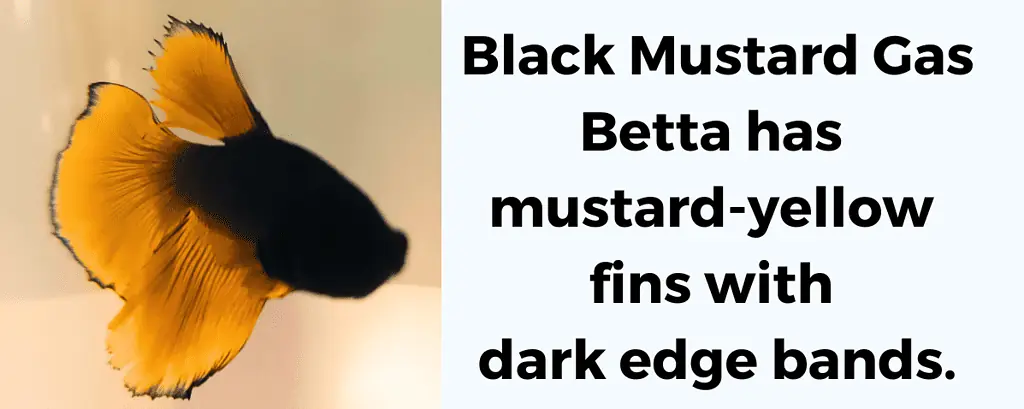
The black Mustard Gas Betta, characterized by a black band skirting the outer edges of its mustard-yellow fins, is a stunning color variant of this pattern.
Dragonscale

This gene change brings about shiny, thicker body scales.
These dragon-like scales often appear in blue Mustard Gas Bettas but sometimes in green ones.
Are Mustard Gas Bettas Rare?
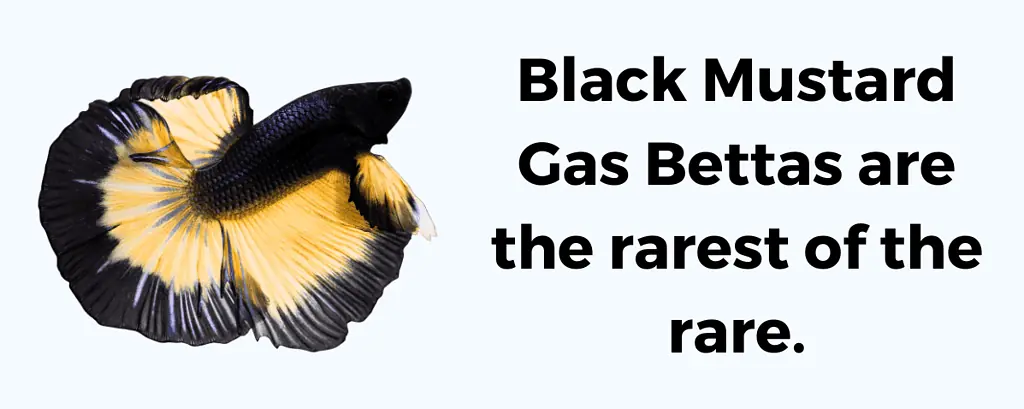
True Mustard Gas Bettas are hard to find today.
Their pure lineage has been mixed and spread out because of ongoing cross-breeding with Bettas of other colors.
This significantly reduces the available authentic Mustard Gas Bettas.
Breeders frequently try to get brighter colors and unique fins.
This often overlooks the original Mustard Gas strain’s genetics. What’s the outcome? Many Bettas on the market display brilliant Mustard Gas colors.
However, they might not be real examples as they don’t always produce the same in breeding.
Your local pet store is unlikely to host a genuine Mustard Gas Betta. But fear not.
If you’re more interested in the creature’s aesthetics, you’ll stumble across plenty of Bettas sporting the famous Mustard Gas coloration.
If you want to own a real Mustard Gas Betta, looking for a special local or online breeder is best. But take your time.
Research thoroughly and ensure the Betta you’re considering is from a trusted breeder.
This careful step increases your chances of getting a genuine Mustard Gas Betta and often ensures a healthy pet.
Well-known breeders keep detailed records of their Bettas’ ancestry and are always willing to answer your questions.
A note on Black Mustard Gas Bettas — these are the rarest of the rare. A genetic flaw in the melano genes leads to female infertility and thus their scarcity.
You’d need to cross your male Black Mustard Gas Bettas with females of different colors, further breeding any subsequent female offspring back with the original male.
Yes, it is a two-step process, but this preserves the traits of the Black Mustard Gas Betta within its bloodline.
Given the complexity of breeding Black Mustard Gas Bettas, it’s no surprise their scarcity further adds to their rarity.
What’s the Average Cost of a Mustard Gas Betta?

The price tag on a Mustard Gas Betta usually falls between $15 and over $60.
Mustard Gas Bettas have always been a hot commodity among aquarium enthusiasts.
As such, they inevitably cost more than Bettas of other color varieties.
Should you come across a Mustard Gas Betta sporting an unusually low price, caution is key — it’s possibly not a genuine specimen.
It’s also important to note that the price of a Mustard Gas Betta can be influenced by its tail type.
Rosetail Bettas, for instance, regardless of their color, typically fetch a higher price owing to their rarity.
If you’re considering an online breeder for your Mustard Gas Betta purchase, don’t forget to factor in the shipping cost.
If offered, looking into shipping insurance might also be a good idea.
This protects you in unfortunate scenarios, such as receiving a sick or deceased Betta.
The Fascinating Breeding History of Mustard Gas Bettas
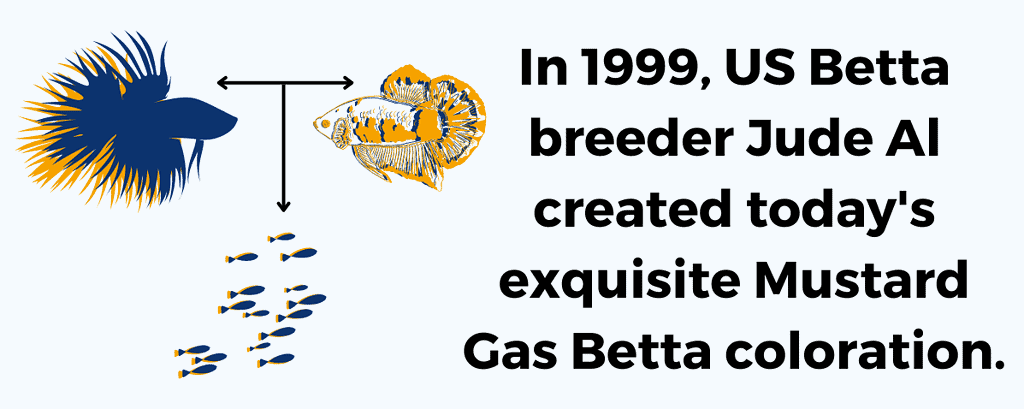
In 1999, the dedicated Betta breeder Jude Al from the US developed the beautiful shades of the Mustard Gas Betta we know today.
Al dedicated thirteen years to developing a Betta fish variety with a unique color, a notable accomplishment in the pet fish realm.
The ancestry of these attractive fish remains a bit mysterious.
However, many in the pet fish community believe the first breeding pair was a sturdy, brown male Betta and a female Betta of either blue or green hue.
Interestingly, Al’s original Bettas had the characteristic of ‘breeding true.
This meant the offspring always had the desired features whenever he bred two Mustard Gas Bettas.
Now, in the 21st century, enthusiasts continue Al’s legacy by working on creating different color versions of the Mustard Gas Betta.
While these variations have the charm of the original strain, they rarely produce ‘true’ offspring.
Decoding the Genetics of a Mustard Gas Betta Fish

The mesmerizing pigmentation of Betta Fish stems from four layers of color pigments.
Each layer’s genetics dictate the vibrant pattern on a Betta’s robe.
In this colorful spectrum, we have:
- The Iridescent layer
- The Black layer
- The Red layer
- The Yellow layer
Although the exact genetic composition of a Mustard Gas Betta remains a mystery, breeders have made educated assumptions:
- The Iridescent layer might contain spread iridescence.
- The Black layer might consist of blonde or bright cells.
- The Red layer might hold non-red cells, fostering yellow hues and having the variegated fin mutation.
Let’s clarify that the Yellow layer doesn’t directly control Bettas’ yellow color. Instead, it affects the opacity trait.
As we explore Betta breeding, these discoveries only make us find the species even more fascinating and impressive.


